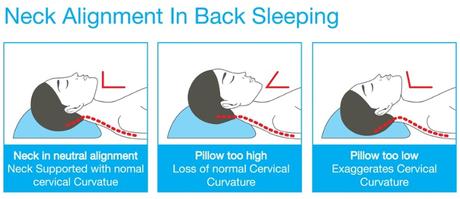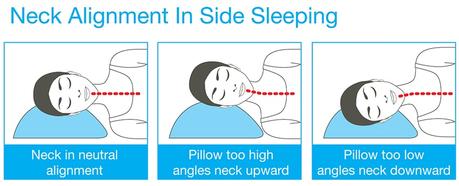Many people suffer neck pain after sleeping. This is more than just a stiff neck since neck pain after sleeping can have serious repercussions on your everyday life. Many people who suffer are desperate to find a solution to what can be a very debilitating issue.
Are there any solutions to this problem? Can the pain be reduced or even eliminated altogether? There are several reasons for neck pain, including herniation or degeneration of the discs between individual vertebrae. Pain can also be the result of a pinched nerve or whiplash. However, if you regularly feel pain on waking that you did not have when you went to bed, then it is likely caused by poor posture when sleeping.
It may be more than just sleeping with your neck in the wrong position as many people think it is. Let's examine why people get such pain, what is the root cause and then how it can be eliminated to give you a relaxing sleep with no issues when you wake up.
The Causes of Suffering Neck Pain After Sleeping
Suffering is the word because neck pain after sleeping can be a very painful and debilitating problem for many people. It is often caused by you sleeping on the wrong pillow, or with your pillow in the wrong position. It is not usually caused simply by you sleeping with your neck twisted in some way. Too high a pillow, or sleeping on two or more pillows, can put stress on your neck when you sleep. Too firm of a pillow or one that is too high can also lead to neck pain after sleeping.
When viewed from the side, the seven vertebrae that make up the neck (known as the cervical vertebrae) are shaped like a slightly flexed bow pointing forwards. Any sleeping position that tries to flatten that shape or to make it curve even more can give rise to a painful condition.

If your head is too high in relation to the bottom of your neck the vertebrae, tendons, and ligaments of your neck may be strained. Your neck muscles can also suffer stress, and all of this can take anything from a day to 3 or 4 days to heal. Meantime your neck will feel painful; not seriously injured, but enough to affect your day to day work, whether at home or in employment.
Our purpose here is to examine the main causes of neck pain and to provide some methods of reducing or even eliminating this. Some may involve changing your bedding while others might be related to your sleeping position. Let's begin with the latter: The position you normally sleep in.
Neck Pain and Your Sleeping Position
Stomach Sleepers
When you sleep on your stomach, your head, and therefore your neck, is forced back against the natural flexibility of your cervical (neck) vertebrae. This can generate stress on the spinal cord which passes through these vertebrae and leads to severe neck pain.
You should try to avoid sleeping on your stomach. However, if you must, then try using a body pillow that can help lessen the angle between your neck and the rest of your spine. Also make sure you rest your head on a pillow that is as thin as possible, or even on no pillow at all. That also reduces the strain on your cervical (neck) vertebrae.
Back Sleepers
Back sleepers tend to suffer less neck pain than other sleeping positions because their neck is bending at a more natural angle when they sleep. Back sleepers can use higher and firmer pillows than stomach sleepers.

Side Sleepers
This is a fairly neutral position to sleep in. Your neck bends to the side which again puts less stress on the cervical vertebrae.

Most times you can marry up your type of pillow with your mattress. If you have a soft Talalay latex mattress or a soft memory foam top to your mattress, you should also use a soft pillow. As your shoulders sink into the mattress, it's important that your head is not stuck in a high position on a hard pillow. This can lead to neck pain, which can be particularly severe if you are a stomach sleeper. It can also affect side sleepers, although to a lesser extent. Stomach sleepers should use a mattress that is on the firm side of medium.
When sitting straight up, bend your head forward as far as you can, keeping your back straight. Now try the same by bending your head to the side, and backward. You will find that your extent of movement is far greater when you bend forwards, less when you bend sideways and very restricted when you try to bend your head backward. These three positions replicate what happens when you are sleeping.
As stated earlier, your mattress and pillow should complement each other to allow your neck to be bent out of its natural position as little as possible. Here are some ideas on how to achieve that.
How to Choose a Pillow to Ease Neck Pain After Sleeping
As explained above the type of pillow you choose can have a significant bearing on neck pain after sleeping. If you decide to use a memory foam pillow, you can choose between shredded and unshredded memory foam. Both can provide excellent support along with comfort. However, if you feel hot when sleeping, the shredded memory foam filling allows better airflow, and hence tends to keep you cooler than the solid types of foam. Fiber and water pillows can also be used to support your head and neck in the correct position.
Shredded Foams: One of the benefits of shredded foams is that you can change the loft (or height) of the pillow by removing or adding foam to it. If you suffer from neck pain after sleeping, then it will likely be easier to ease the pain if you use a pillow such as this. It could be that all you need do is to remove some of the fillings to lower your head, and therefore the angle between your head and your shoulders. This, in turn, will ease the pressure on your neck or cervical vertebrae.
Shaped Pillows: It is also possible to purchase shaped pillows that keep your head and neck in the correct position relative to each other and both correctly positioned relative to the rest of your body. These pillows cannot be used by stomach sleepers.
Stomach Sleepers: We have already advised that stomach sleepers should use a thin pillow - as thin as they can comfortably sleep on. In fact, many stomach sleepers use no pillow at all. This helps to maintain the natural curve of your neck (cervical) vertebrae.
How to Ease Neck Pain From Sleeping: Summary
We have discussed why people feel neck pain after sleeping, and the root causes of this pain. It is fundamentally due to pressure put on your neck or cervical vertebrae by your sleeping position. It's not easy to keep your head in the correct alignment with your neck, although you can help achieve this by using the correct pillow.
When choosing a pillow you should take the firmness of your mattress relative to that of your pillow into consideration. A hard pillow and soft mattress will tend to allow your shoulders to sink down into the mattress, increasing the angle between your head and spine. Your cervical vertebrae are situated at the top of your spine and are set in a natural curve that must be maintained when you sleep if you are not to suffer pain.
Here at InsideBedroom, we are aware of the importance of the correct choice of pillow and have carried out a review of the best pillows to help prevent you suffering neck pain. Click here to find our ten best pillows for neck pain. So is it possible to ease neck pain after sleeping? Sure it is - but you have to take positive steps to reduce such pain or even avoid it altogether.

